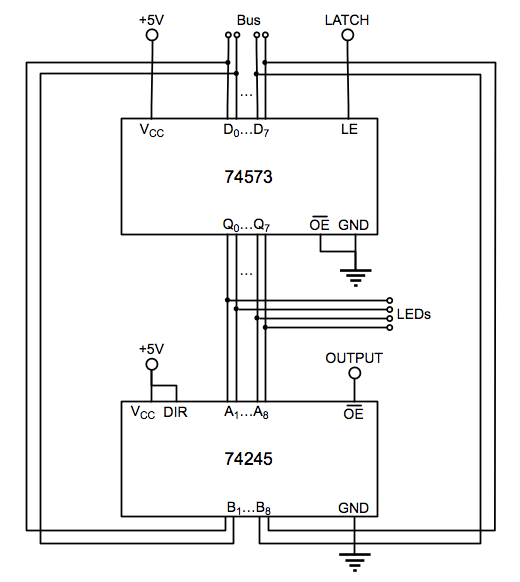8-bit Register with LEDs
Update: After looking through a copy of Computer Organization and Design that I got for $2 at Gould’s, I realize that a flip-flop (which is clock edge triggered) would be a better choice than a latch (which is level triggered, and more complicated to deal with in a large system). A good choice seems to be the 74574.

Just for fun, I’m working on building a basic CPU. At this point I think it
will contain three user addressable 8-bit registers (r1, r2, r3) as well
as a PC register and two registers to contain the high and low bytes of the
current instruction. (There will also be an ALU and memory.)
I’ve been reading a lot about register and latch ICs, and I think I’ve figured
out how to build the registers. They’ll need to connect to an 8-bit bus, so
that e.g. with a mov r1, r2 instruction r2 will own the bus, writing its
value to it, and r1 will latch the value on the bus. So each register board
(I’ll probably build them on separate pieces of vero) will have the following
terminals:
-
D0-7– the lines of the bus. -
OUTPUT(active low) – when this is low, the register owns the bus and outputs its value. When it’s high, the register board’s outputs are in a high impedance state. -
LATCH– when you want to write to the register, ensure the bus contains the appropriate value and then bring this momentarily high, then low again. Keep it low to retain the value.
This seems very easy to build with a 74573 transparent latch IC:
-
D0-7are just the inputs to the IC. -
Attach
OUTPUTto the active-lowOEpin on the IC. -
Attach
LATCHto theLEpin on the IC. -
Connect the IC’s outputs (
Q0-7) to its inputs (D0-7). If I understand correctly, this won’t cause any problems because whenOUTPUTis low the outputs are high impedance, and when it’s high you should have the register latched anyway.
The latch IC acts both as the register itself and as a bus transceiver.
I think it would be cool to have each register board also contain an 8-bit LED display of its current value for debugging purposes, especially when I’m first building the system. To do that the latch IC needs to always output its contents though, which means I’ll need a separate buffer, like the 74245 bus transceiver. It seems sufficient to put the buffer between the latch IC’s outputs and its inputs, and to connect the LEDs between the latch IC’s outputs and the buffer.